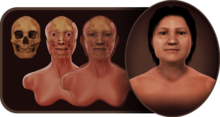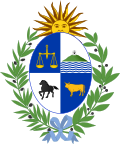


| This article is part of a series on the |
| Culture of Uruguay |
|---|
 |
|
Uruguay Portal |
Indigenous peoples in Uruguay or Native Uruguayans, are the peoples who have historically lived in the modern state of Uruguay. Because of colonial practices, disease and active exclusion, only a very small share of the population is aware of the country's indigenous history or has known indigenous ancestry.[3][4]
Scholars disagree agree about the first settlers in what is now Uruguay, but there is evidence of human presence from 10,000 BCE. Indigenous Uruguayans disappeared in the 1830s and, with the exception of the Guaraní, little is known about these peoples and even less about their genetic characteristics.[5] The Charrúa peoples were perhaps the best-known indigenous people of the Southern Cone in what was called the Banda Oriental.[6] Other significant tribes were the Minuane, Yaro, Güenoa, Chaná, Bohán and Guaraní, and the Arachán. Languages once spoken in the area include Charrúa, Chaná, Güenoa, and Guaraní.
A 2005 genetic study showed 38% of Uruguayans had some indigenous ancestry.[7][8] In the 2011 Census, 4.9% of the population reported having indigenous ancestry.[4] A 2004 DNA study in the American Journal of Human Biology suggested that the Native American contribution to Uruguay's genetic composition may be far higher than is commonly assumed.[9]
- ^ Cite error: The named reference
cícerowas invoked but never defined (see the help page). - ^ Cite error: The named reference
museoswas invoked but never defined (see the help page). - ^ "South America :: Uruguay — The World Factbook - Central Intelligence Agency". www.cia.gov.
- ^ a b "Atlas Sociodemografico y de la Desigualdad en Uruguay, 2011: Ancestry" (PDF) (in Spanish). National Institute of Statistics. Archived from the original (PDF) on 2014-11-13.
- ^ Sans, Monica; Figueiro, Gonzalo; Sanguinetti, Carlos; Echarte-Rafaelli, Lourdes; Portela, Cecilia; Taranto, Luis; Pizzarossa, Carlos; Oliver, Roberto; Manikowski, Rosana; Barreto, Isabel; Hidalgo, Pedro; Berro, Guido. "The last Charrua Indian; (Uruguay): analysis of the remains of Chief Vaimaca Per". Nature Precedings – via www.academia.edu.
- ^ Burford, Tim (2011). The Bradt Travel Guide Uruguay. Bucks, UK: Bradt Travel Guides. ISBN 978-1-84162-316-0.
- ^ Da Silva Villarrubia, Santiago Katriel (14 July 2011). "Dra. Sinthia Pagano. Un Estudio Detectó 38% de Sangre Aborigen en la Población Uruguaya - En Uruguay hay 115.118 descendientes de indígenas". Mario Delgado Gérez (in Spanish). LaRed21 Comunidad. Retrieved 6 February 2013.
- ^ Da Silva Villarrubia, Santiago Katriel (27 August 2011). "Censo 2011. Organizaciones Sociales Llaman a Decir "Sí" Para Reconocer sus Etnias - Censo: afrodescendientes e indígenas hacen campaña". Matías Rotulo (in Spanish). LaRed21 Comunidad. Retrieved 6 February 2013.
- ^ Bonilla, Carolina (2004). "Substantial native American female contribution to the population of Tacuarembó, Uruguay, reveals past episodes of sex-biased gene flow". American Journal of Human Biology. 16 (3): 289–297. doi:10.1002/ajhb.20025. PMID 15101054. S2CID 34341356.
© MMXXIII Rich X Search. We shall prevail. All rights reserved. Rich X Search
